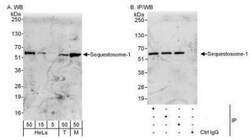Promotional price valid on web orders only. Your contract pricing may differ. Interested in signing up for a dedicated account number?
Learn More
Learn More
p62/SQSTM1 Antibody, Novus Biologicals™


Rabbit Polyclonal Antibody has been used in 4 publications
Supplier: Novus Biologicals NBP149954
Description
p62/SQSTM1 Polyclonal specifically detects p62/SQSTM1 in Human, Mouse, Canine samples. It is validated for Western Blot, Simple Western, Immunohistochemistry, Immunoprecipitation, Immunohistochemistry-Paraffin.Specifications
| p62/SQSTM1 | |
| Polyclonal | |
| Unconjugated | |
| Tris-Citrate/Phosphate (pH 7.0 - 8.0) with 0.09% Sodium Azide | |
| A170, EBI3-associated protein of 60 kDa, EBI3-associated protein p60, EBIAP, ORCA, OSIL, oxidative stress induced like, p60PDB3, p62, p62B, Paget disease of bone 3, phosphotyrosine independent ligand for the Lck SH2 domain p62, Phosphotyrosine-independent ligand for the Lck SH2 domain of 62 kDa, sequestosome 1, sequestosome-1, Ubiquitin-binding protein p62, ZIP3 | |
| Rabbit | |
| Affinity Purified | |
| RUO | |
| Primary | |
| Based on 100% sequence identity, this antibody is predicted to react with Panda, Orangutan, Gorilla, Chimpanzee, White-tufted-ear marmoset, Naked mole rat, and African elephant. | |
| Store at 4C. Do not freeze. |
| Western Blot, Immunohistochemistry, Immunoprecipitation, Immunohistochemistry (Paraffin) | |
| 1.0 mg/mL | |
| Western Blot 1:2000-1:10000, Simple Western 1:40, Immunohistochemistry 1:500 to 1:2000, Immunoprecipitation 2-5 ug/mg lysate, Immunohistochemistry-Paraffin 1:500 to 1:2000 | |
| Q13501 | |
| SQSTM1 | |
| The immunogen for this product maps to a region between residue 325 and 375 of human Sequestosome-1 using the numbering given in entry NP_003891.1 (GeneID 8878). | |
| 100 μL | |
| Autophagy, Signal Transduction | |
| 8878 | |
| Human, Mouse, Canine | |
| IgG |
Product Content Correction
Your input is important to us. Please complete this form to provide feedback related to the content on this product.
Product Title
For Research Use Only
Spot an opportunity for improvement?Share a Content Correction


